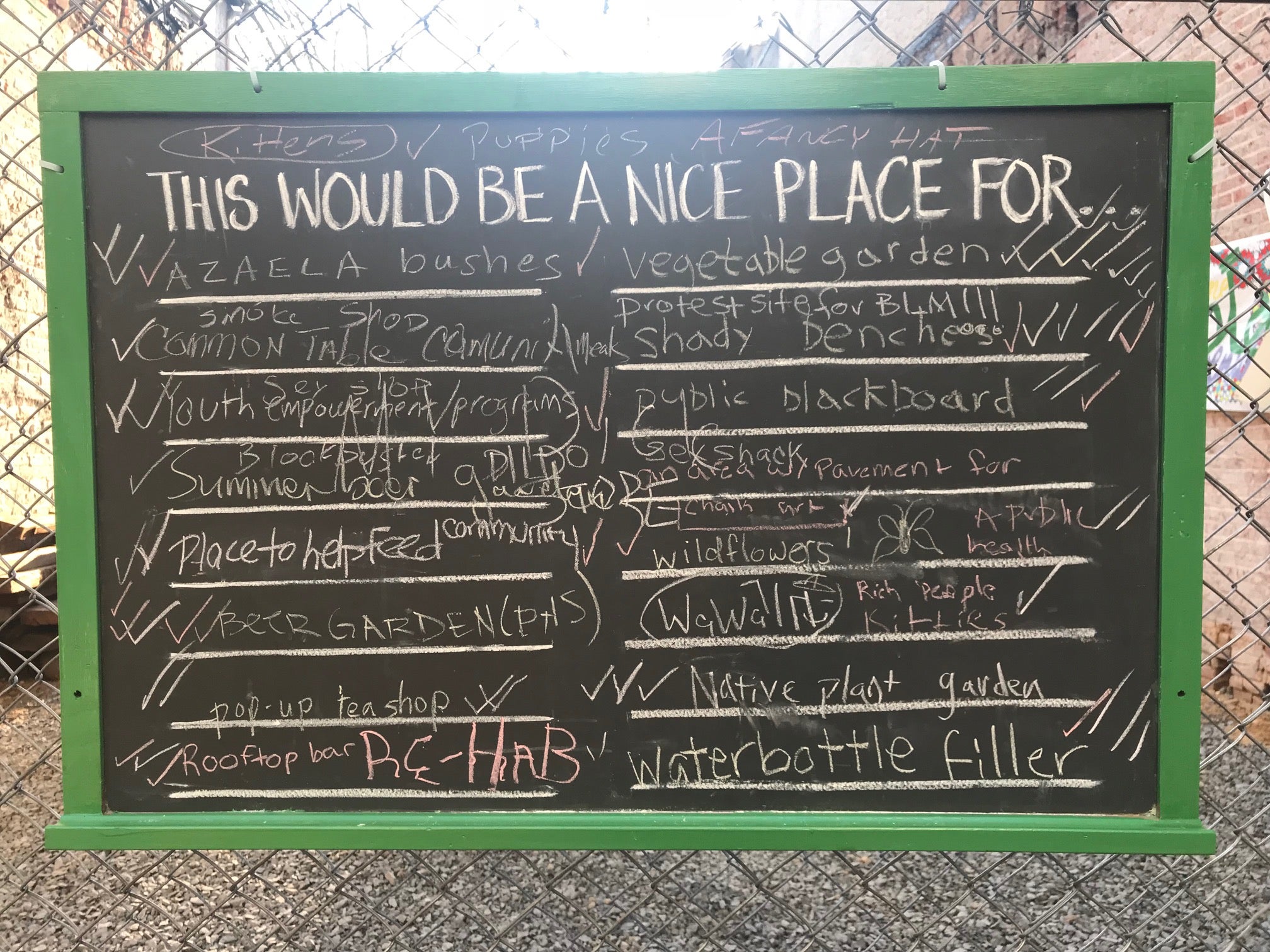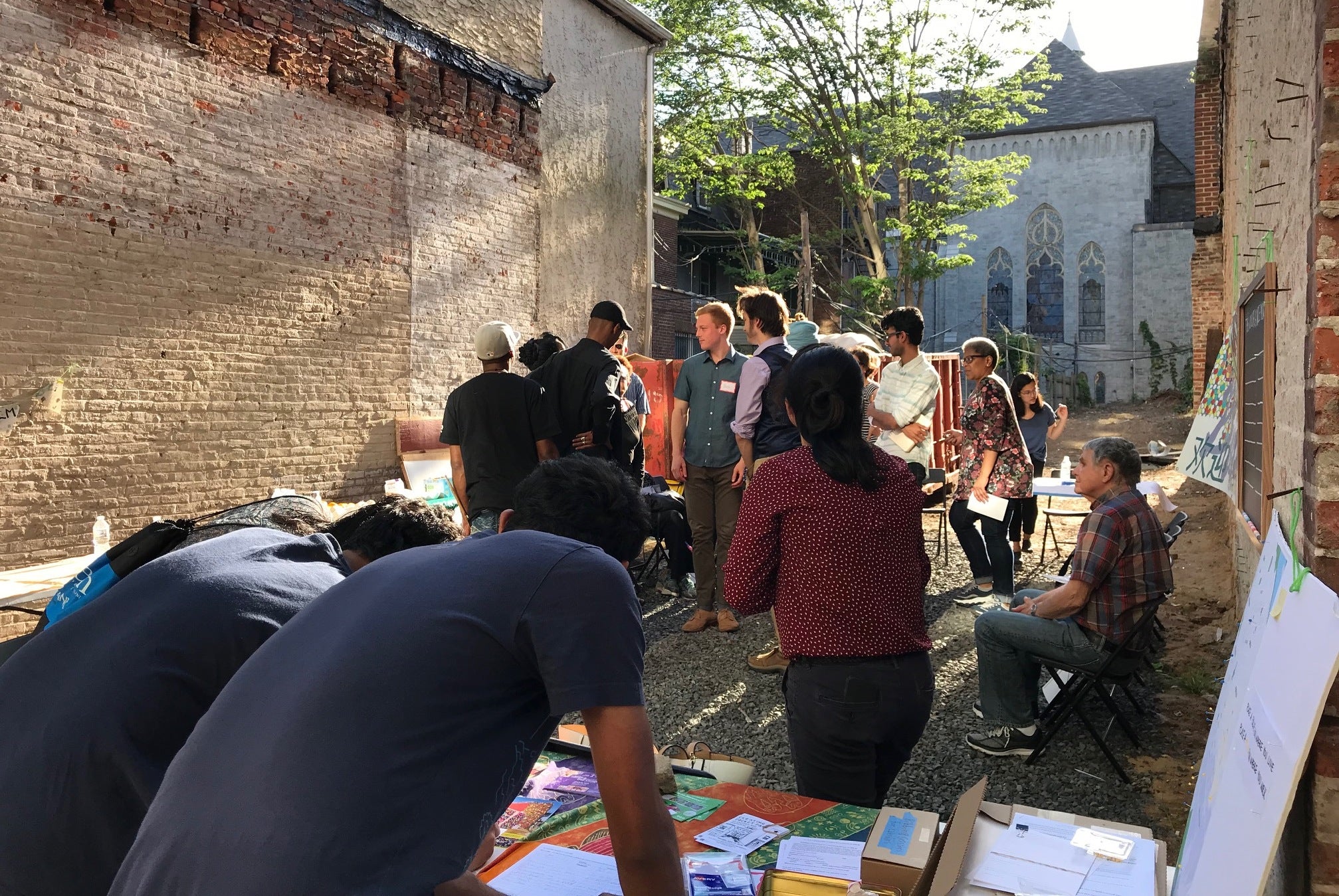In West Philadelphia, a park collaboration in progress

In a time of such rapid development, it is important for community members to access spaces that have a sense of openness, permanence, and stability.
That sentiment, voiced by an attendee at one of the five public forums hosted this summer by Al-Bustan Seeds of Culture, is shared by many neighbors and longtime residents of West Philadelphia. It also echoes our interests in our latest initiative to create a publicly accessible pocket park on 40th Street between Chestnut and Ludlow streets.
Al-Bustan, Arabic for the garden, is a nonprofit based in West Philadelphia that was founded in 2002 with the goal of celebrating and sharing Arab culture through the arts and language. Our summer youth camps, after-school programs, and performance series have allowed us to reach diverse communities across the city, promoting cross-cultural understanding and exchange among people of all backgrounds. As our organizational capacity has grown and matured, we have sought more opportunities to deepen our community engagement and partnerships through socially engaged arts and cultural programming that enables meaningful dialogue and forges new collaborations.
The pocket-park initiative follows the production of two large-scale public arts projects that we created in collaboration with fellow Philadelphians. “An Immigrant Alphabet“ is an exploration of immigrant identity with youth at Northeast High School that was displayed as a 11-month-long interactive installation at the Municipal Services Building. “(DIS)PLACED: Philadelphia | Expressions of Identity in Transition” is a deeply personal look into narratives of displacement and adaptation as experienced by recent refugees, immigrants, and those living in a neighborhood in transition, and reflected upon by four artists-in-residence of Arab heritage – including the creation of a mural in West Philadelphia by eL Seed, titled “Soul of the Black Bottom.”
As we expand upon our socially engaged work, we seek not only to explore these salient themes around identity and amplify marginalized voices, but also to be more responsible and active neighbors in the neighborhood that has been home to us for the past decade and a half. Inspired by the journeys of adaptation that were shared with us during “iAlphabet” and “(DIS)PLACED,” and drawing upon the relationships that we built in West Philly during the creation of the mural, Al-Bustan set out to create something more permanent for the neighborhood and its people.

In a place where new developments are rapidly emerging, publicly accessible open spaces have become a rare sight around University City. In partnership with local developer UC West, Al-Bustan hopes that, through this project, we can do our part in counteracting this trajectory of dwindling neighborhood space. The pocket park that we are creating takes inspiration from Andalusian-era convivencia, bringing people from all walks of life and different backgrounds for celebration and co-creation of visual arts, performance, cuisine, and other forms of cultural storytelling. This is especially important in a neighborhood as racially, ethnically, economically, and generationally diverse as West Philly. This theme of co-creation will not only manifest in the eventual use of the pocket park, but is informing our entire process of planning, designing, building, and programming of this new neighborhood space.
We are invested in hearing from people in the neighborhood who will be using the space. At a junction of such diversity, we recognize the importance of being mindful of the differing needs of the people that we are serving. Since May, we have set out to hear and learn from these diverse constituents. Members of our team have visited local businesses to speak with owners, reached out to neighborhood organizations, chatted with residents, students, and workers, and reconnected with old friends that we made during “DIS(PLACED),” inviting them to join in our conversations. These people came together in our community forums to discuss their favorite neighborhood spaces, what they thought made a welcoming public space, what they wanted to be able to do in this new space, and what West Philly meant to them.
Our neighbors shared their thoughts about the increased focus on sustainability, about the value of co-creation in artmaking, about the potential for this space to capture and celebrate the diverse cultures of West Philadelphia, and the necessity to recognize and tell the rich history of the neighborhood known to longtimers as “The Black Bottom.”
Inspired by the topics that participants identified to be important in our first two meetings, we convened two focus-group sessions to talk further about ways in which we could incorporate specific realms that held programmatic significance. In our arts focus discussion, a group of artists and makers from West Philly gathered to talk about ways in which the creation and content of art can capture the history and diversity of the neighborhood. In our food focus discussion, we spoke about food production and sharing as universal language, and ways in which we could celebrate the uniqueness of the neighborhood through cultural foods and sustainable planting.
The thoughtful conversation and insightful comments that were shared with us during these meetings encouraged us to think about this project from new angles, and broaden our network of friends and partners. Besides these public meetings, we also visited other neighbors who frequently pass by the space, such as students at Paul Robeson High School, and elderly residents at University Square Apartments. Through all of these conversations, and silent dialogue we captured through interactive suggestion boards on the site, we learned so much about West Philly’s passions, histories, and talents. These fruitful conversations highlighted the importance of community engagement, and reinforced the idea that the community is a creative partner in our journey to making this place.

With these complex ideas of sustainability, co-creation, inclusion, and history in mind, we engaged a landscape-architect team with roots in West Philly to conceptualize a schematic design of the park. Anu Mathur, Dilip da Cunha, and Prakul Pottapu shared some of their initial design concepts for the park at a public meeting in August, and will continue to share their ideas throughout this iterative process of creation. The park will give space to all kinds of gatherings, bringing together the diverse communities that have made West Philly their place of home, work, study, and play.
As our neighbors echoed throughout the summer, public spaces provide an opportunity for people to come together and bridge divides. Al-Bustan aims to not only create a space of recreation, but also of dialogue, understanding, and safety. Creating a new neighborhood space that the community will find value in is an experience that is both exciting and humbling. We are encouraged by the excitement that has been generated around the pocket park this summer, and are thrilled about the possibilities and potential that have been pointed out to us.
We also recognize that there is still so much to learn from the people around us, and we hope that West Philadelphia will continue to share its innovation, creativity, and heart with us.
This article was co-written by Heather Liang, Al-Bustan Seeds of Culture summer intern/community planning coordinator.
WHYY is your source for fact-based, in-depth journalism and information. As a nonprofit organization, we rely on financial support from readers like you. Please give today.




